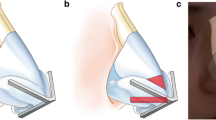Abstract
Background
The paranasal depression is a common facial feature of Oriental populations. One of the most wildly used method to improve it was paranasal augmentation using expanded polytetrafluoroethylene (ePTFE). The effectiveness of it should be tested by three-dimensional morphological measurements.
Methods
Patients who underwent paranasal augmentation using ePTFE between January 2017 and December 2022 were recruited in the study. The preoperative and postoperative clinical variables and three-dimensional measurement of patients were also collected. The satisfaction outcome were assessed.
Results
By establishing a coordinate system based on the Frankfurt plane, 16 landmarks including nasal alar crest, subnasal point, upper lip, pogonion, glabella, sub-cheek, orbitale, tragion in left and right side of faces were marked. Five segments, 4 ratios, and 3 angles were measured based on it. The significant increase of segments, ratios, and angles indicated that paranasal augmentation could increase the protrusion of paranasal area, both in absolute value and relative proportion. The significant decrease of other data indicated that the protrusion difference between paranasal base and upper lip, forehead, and chin, respectively, were shortened after surgery. The average size of implant was 6.54 ± 1.02 mm, and the average increase of paranasal height was 4.38 ± 1.04 mm postoperatively. This indicates that two-thirds of its height will ultimately be reflected effectively in the sagittal elevation of the paranasal base.
Conclusions
Paranasal augmentation using ePTFE could effectively increase paranasal height and improve subunits relationships, and the ePTFE prosthesis should be designed and carve considering the 1/3 loss of height after implantation.
Level of Evidence III
This journal requires that authors assign a level of evidence to each article. For a full description of these Evidence-Based Medicine ratings, please refer to the Table of Contents or the online Instructions to Authors www.springer.com/00266.






Similar content being viewed by others
References
Park JH, Kim JW, Kim SJ (2016) Midfacial soft-tissue changes after paranasal augmentation with porous polyethylene. Facial Plast Surg 32:232–237
Zhai Z, Zhao J, Qi Z (2022) Paranasal augmentation: a viable and simplified modality with diced expanded polytetrafluoroethylene. J Craniofac Surg 33:e613–e616
Lee TY, Chung HY, Dhong ES, Jeong SH, Han SK (2019) Paranasal augmentation using multi-folded expanded polytetrafluorethylene (ePTFE) in the east Asian nose. Aesthet Surg J 39:1319–1328
Kim JH, Jung MS, Lee BH, Jeong HS, Suh IS, Ahn DK (2016) Silicone implant-based paranasal augmentation for mild midface concavity. Arch Craniofac Surg 17:20–24
Zhang J, Li D, Liu Y et al (2022) Application of patient-specific PEEK implant for aesthetic considerations in paranasal augmentation. J Craniofac Surg 33:e877–e880
Ordynowski L (2022) Cross-linked hyaluronic acid for cleft lip and palate aesthetic correction: a preliminary report. Aesthet Surg J Open Forum 4:ojac0052
de Maio M, De Boulle K, Braz A, Rohrich RJ, Alliance for the Future of Aesthetics Consensus, C (2017) Facial assessment and injection guide for botulinum toxin and injectable hyaluronic acid fillers: focus on the midface. Plast Reconstr Surg 140:540–550
Dong W, Xu Y, Han R, Zheng R, Fan F (2022) Paranasal augmentation using diced costal cartilage for midface concavity: a retrospective study of 68 patients. Aesthetic Plast Surg 46:795–802
Gruber RP, Freeman MB, Hsu C, Elyassnia D, Reddy V (2009) Nasal base reduction: a treatment algorithm including alar release with medialization. Plast Reconstr Surg 123:716–725
Yaremchuk MJ, Doumit G, Thomas MA (2011) Alloplastic augmentation of the facial skeleton: an occasional adjunct or alternative to orthognathic surgery. Plast Reconstr Surg 127:2021–2030
Park HS (2001) Lambda-shaped implant for augmentation of anterior nasal spine in Asian rhinoplasty as an ancillary procedure. Aesthetic Plast Surg 25:8–14
Kwak ES (2010) Asian cosmetic facial surgery. Facial Plast Surg 26:102–109
Yaremchuk MJ, Vibhakar D (2016) Pyriform aperture augmentation as an adjunct to rhinoplasty. Clin Plast Surg 43:187
An Y, Wang G, Li X, Zhen Y, Zhao J, Li D (2022) Rhinoplasty with simultaneous autologous full-face fat transfer for Asian facial contouring balance: a retrospective study. Aesthetic Plast Surg 47(2):746–756
Metzler P, Geiger EJ, Chang CC, Sirisoontorn I, Steinbacher DM (2014) Assessment of three-dimensional nasolabial response to Le Fort I advancement. J Plast Reconstr Aesthet Surg 67:756–763
Kim M, Lee DY, Lim YK, Baek SH (2010) Three-dimensional evaluation of soft tissue changes after mandibular setback surgery in class III malocclusion patients according to extent of mandibular setback, vertical skeletal pattern, and genioplasty. Oral Surg Oral Med Oral Pathol Oral Radiol Endod 109:e20-32
Yen CI, Chen RF, Zelken J et al (2018) The influence of paranasal augmentation on the measurement of the nose for the treatment of midfacial concavity. Aesthet Surg J 38:241–251
Acknowledgement
None.
Author information
Authors and Affiliations
Corresponding author
Ethics declarations
Conflict of interest
The authors declare no competing financial interests.
Ethical approval
Our experiments were in accordance with the ethical standards formulated in the Helsinki Declaration. The research procedures were approved by the Medical Science Research Ethics Committee of the Third Hospital of Peking University (ethical approval number: IRB00006761-M2022152). Consent was obtained from the participants responding to the follow-up surveys.
Additional information
Publisher's Note
Springer Nature remains neutral with regard to jurisdictional claims in published maps and institutional affiliations.
Supplementary Information
Below is the link to the electronic supplementary material.
Supplementary file1 (MP4 67466 kb)
Rights and permissions
Springer Nature or its licensor (e.g. a society or other partner) holds exclusive rights to this article under a publishing agreement with the author(s) or other rightsholder(s); author self-archiving of the accepted manuscript version of this article is solely governed by the terms of such publishing agreement and applicable law.
About this article
Cite this article
Wang, G., Wei, M., Zhen, Y. et al. Three-Dimensional Morphological Study on the Effectiveness of Expanded Polytetrafluoroethylene Prosthesis in the Paranasal Augmentation. Aesth Plast Surg 48, 398–406 (2024). https://doi.org/10.1007/s00266-023-03755-8
Received:
Accepted:
Published:
Issue Date:
DOI: https://doi.org/10.1007/s00266-023-03755-8




